Шашков В.А. ИСТ-21 кр1. Контрольная работа по дисциплине Основы администрирования сетевых устройств
 Скачать 400.86 Kb. Скачать 400.86 Kb.
|
|
Министерство цифрового развития, связи и массовых коммуникаций Российской Федерации Сибирский государственный университет телекоммуникаций и информатики Межрегиональный учебный центр переподготовки специалистов Контрольная работа по дисциплине «Основы администрирования сетевых устройств» Выполнил: Шашков В.А. Группа: ИСТ-21 Вариант: Проверил(а): г. Новосибирск 2022
Задание: Сформировать компьютерную сеть для 2 офисов, территориально расположенных в одном городе, но на некотором удалении друг от друга. Исходные данные формируются студентом самостоятельно. Для организации сети распределить и использовать следующие входные данные: - Количество коммутаторов L2: от 2 до 4; - Количество маршрутизаторов L3: от 1 до 2; - Количество точек доступа: от 2 до 5; - Количество компьютеров (проводной интерфейс Ethernet): 10 + последняя цифра пароля; - Количество компьютеров (беспроводной интерфейс IEEE 802.11): не менее 3; - Количество серверов в каждом офисе: не менее 2; Линии между офисами должны быть согласованы на скорости 1Gbps, тип кабеля выбирается следующим образом: если последняя цифра пароля четная — медный кабель, если нечетная — кабель оптический. Выполнение: 1. Определить расположение двух офисов на физической плоскости. Привязка к карте и определение расстояния будет плюсом. 2. Сформировать логическую схему сети, распределить оконечное оборудование между офисами примерно поровну. 3. Сетевое оборудование распределить в зависимости от потребностей п.2. 4. В среде моделирования Cisco Packet Tracer Student (или аналогичной) создать сеть по разработанной в п.2 и 3 схеме сети. 5. Выполнить настройку всех сетевых интерфейсов, обеспечив работу сети передачи данных. Для этого: - Разбить сеть на сегменты, разработать план статической IP адресации. Для сегмента сети с серверами разработать бесклассовую маску и назначить публичные («белые») IP адреса; - Подключить беспроводные интерфейсы обеспечив безопасное соединение. Убедиться, что все устройства распределены на физической плоскости и находятся в зоне покрытия точек доступа (для каждого из офисов); - Настроить протоколы маршрутизации и интерфейсы для взаимодействия между офисами. 6. Реализовать простое ограничение доступа (пересылки пакетов), когда пользователи одного офиса могут обмениваться данными между собой и серверами обоих офисов. Доступ между ПК разных офисов должен быть закрыт! Параметры, которые не указаны в задании выбираются студентом самостоятельно! Методика формирования сети описана в лабораторных работах №1-3. В контрольной работе отразить полученные результаты: описание этапов создания схемы сети; логическую схему сети и физическое расположение офисов; администрирования используемых сетевых устройств; выводы по работе. Выполнение. Схема сеть для 2 офисов, территориально расположенных в одном городе, но на некотором удалении друг от друга. 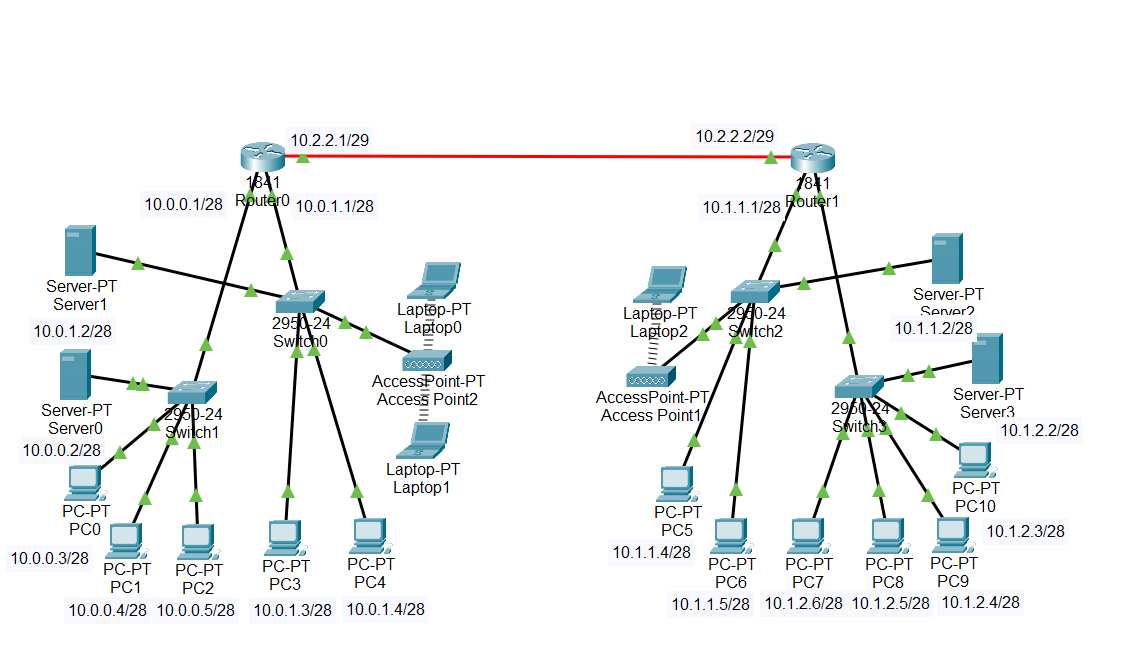 Рис. 1 схема сети. Линия сети между офисами организована по ВОЛС стык 1Gbe. 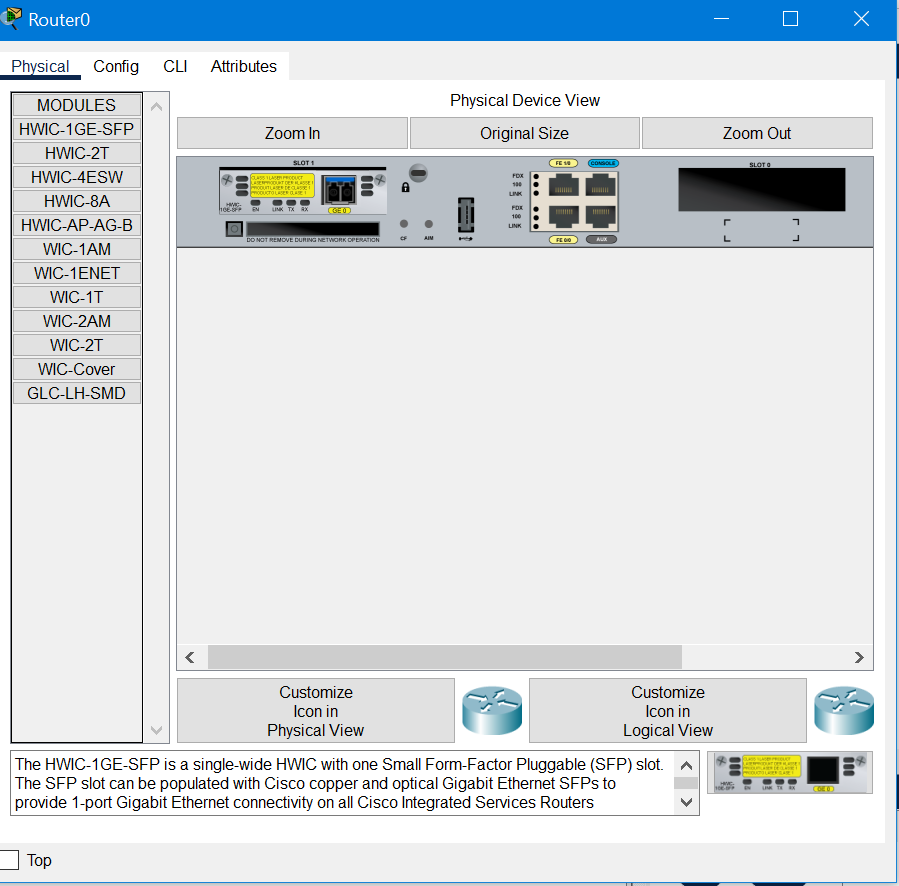 Рис. 2 Монтаж платы и SFP модуля. Настройка интерфейсов PC: 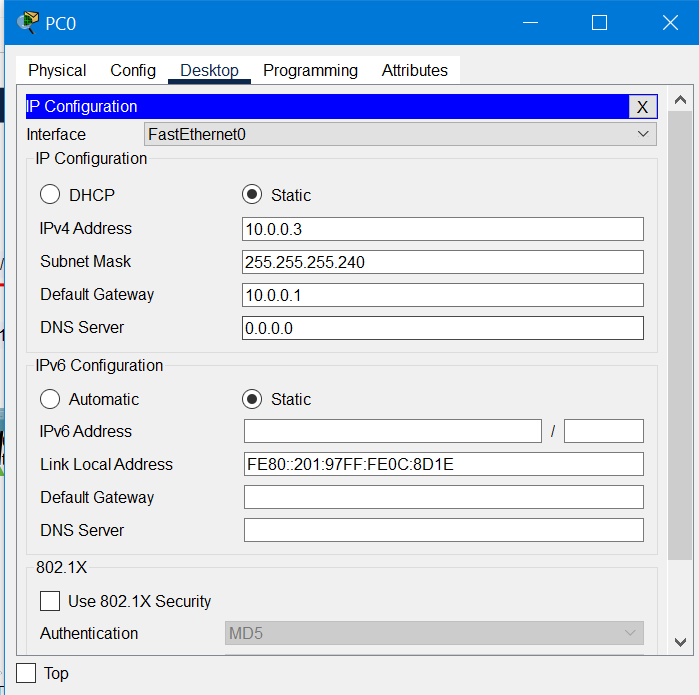 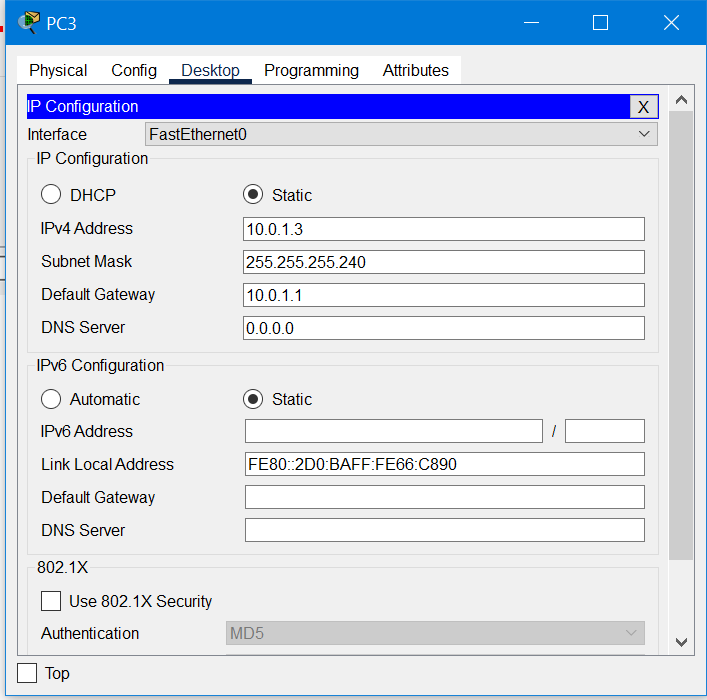 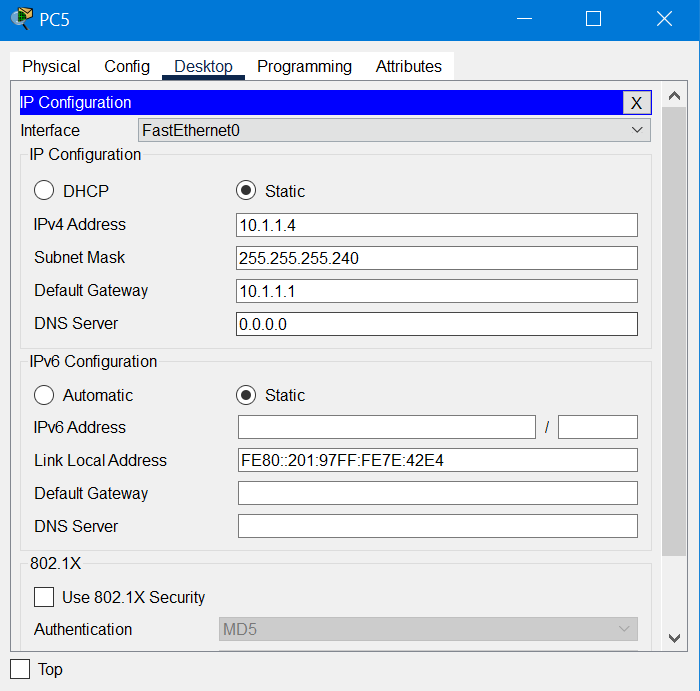 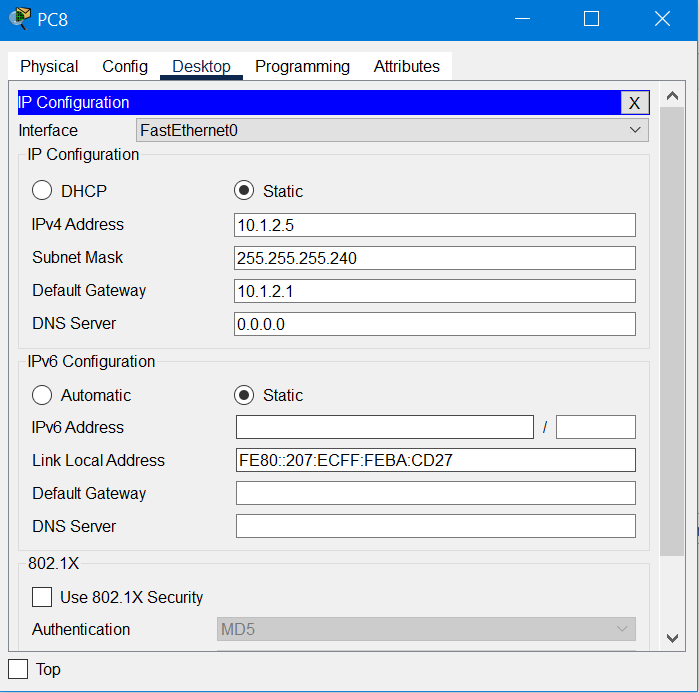 Настройка безпроводнойсети 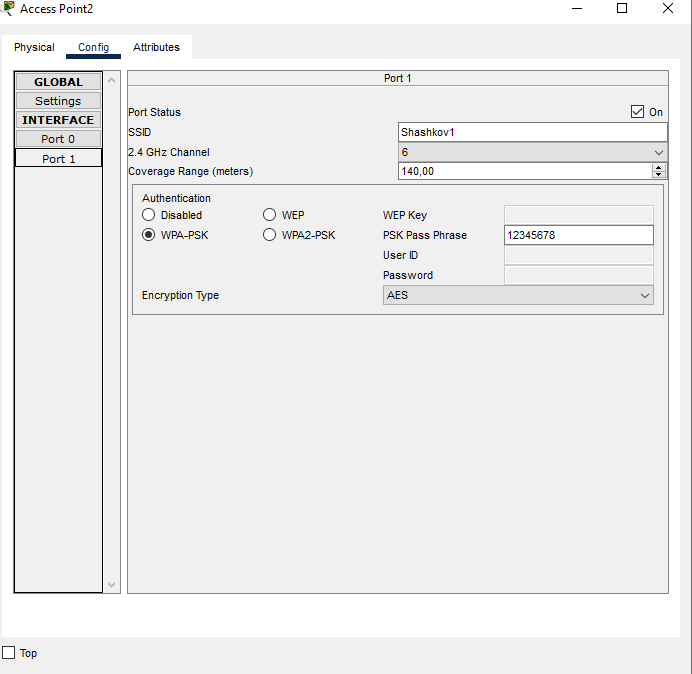 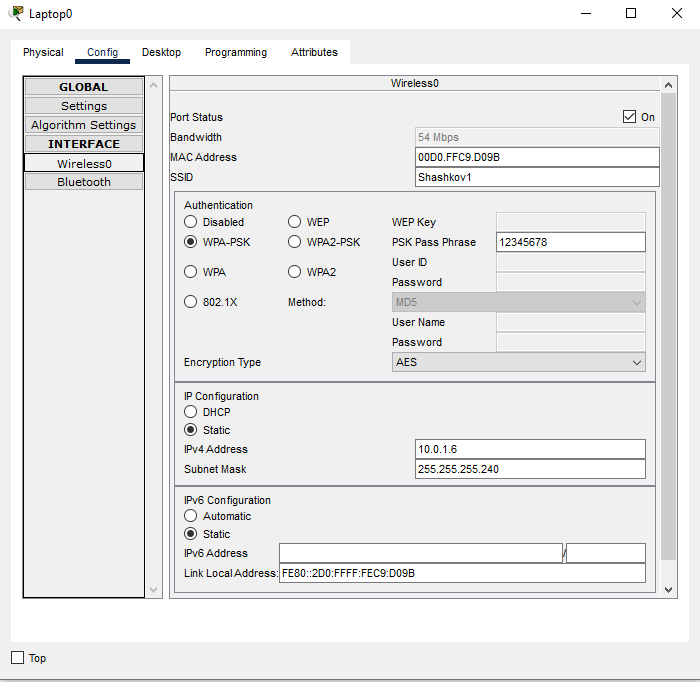 Настройка маршрутизаторов Router0 interface FastEthernet0/0 ip address 10.0.1.1 255.255.255.240 ip access-group 101 in ip access-group 101 out duplex auto speed auto ! interface FastEthernet0/1 ip address 10.0.0.1 255.255.255.240 ip access-group 101 in ip access-group 101 out duplex auto speed auto ! interface GigabitEthernet0/1/0 ip address 10.2.2.1 255.255.255.248 ! interface Vlan1 no ip address shutdown ! router rip ! Настройка маршрутизации ip classless ip route 10.1.1.0 255.255.255.240 10.2.2.2 ip route 10.1.2.0 255.255.255.240 10.2.2.2 ! Настройка ACL список контроля доступа. access-list 101 permit ip 10.0.0.0 0.0.0.15 10.0.1.0 0.0.0.15 access-list 101 permit ip 10.0.1.0 0.0.0.15 10.0.0.0 0.0.0.15 access-list 101 permit ip 10.1.1.0 0.0.0.15 host 10.0.0.2 access-list 101 permit ip 10.1.1.0 0.0.0.15 host 10.0.1.2 access-list 101 permit ip 10.1.2.0 0.0.0.15 host 10.0.0.2 access-list 101 permit ip 10.1.2.0 0.0.0.15 host 10.0.1.2 access-list 101 permit ip host 10.0.0.2 10.1.1.0 0.0.0.15 access-list 101 permit ip host 10.0.1.2 10.1.1.0 0.0.0.15 access-list 101 permit ip host 10.0.0.2 10.1.2.0 0.0.0.15 access-list 101 permit ip host 10.0.1.2 10.1.2.0 0.0.0.15 access-list 101 permit ip 10.0.0.0 0.0.0.15 host 10.1.1.2 access-list 101 permit ip 10.0.0.0 0.0.0.15 host 10.1.2.2 access-list 101 permit ip 10.0.1.0 0.0.0.15 host 10.1.1.2 access-list 101 permit ip 10.0.1.0 0.0.0.15 host 10.1.2.2 access-list 101 permit ip host 10.1.1.2 10.0.0.0 0.0.0.15 access-list 101 permit ip host 10.1.2.2 10.0.0.0 0.0.0.15 access-list 101 permit ip host 10.1.1.2 10.0.1.0 0.0.0.15 access-list 101 permit ip host 10.1.2.2 10.0.1.0 0.0.0.15 Router1 interface FastEthernet0/0 ip address 10.1.1.1 255.255.255.240 duplex auto speed auto ! interface FastEthernet0/1 ip address 10.1.2.1 255.255.255.240 duplex auto speed auto ! interface GigabitEthernet0/1/0 ip address 10.2.2.2 255.255.255.248 ! interface Vlan1 no ip address shutdown ! ip classless ip route 10.0.0.0 255.255.255.240 10.2.2.1 ip route 10.0.1.0 255.255.255.240 10.2.2.1 Проверяем соединение (ping) меду офисами согласно условию задания. Реализовать ограничение доступа, когда пользователи одного офиса могут обмениваться данными между собой и серверами обоих офисов. Доступ между ПК разных офисов должен быть закрыт. PC0 C:\>ping 10.0.0.2 Pinging 10.0.0.2 with 32 bytes of data: Reply from 10.0.0.2: bytes=32 time<1ms TTL=128 Reply from 10.0.0.2: bytes=32 time<1ms TTL=128 Ping statistics for 10.0.0.2: Packets: Sent = 2, Received = 2, Lost = 0 (0% loss), Approximate round trip times in milli-seconds: Minimum = 0ms, Maximum = 0ms, Average = 0ms Control-C ^C C:\>ping 10.0.0.3 Pinging 10.0.0.3 with 32 bytes of data: Reply from 10.0.0.3: bytes=32 time<1ms TTL=128 Reply from 10.0.0.3: bytes=32 time=5ms TTL=128 Ping statistics for 10.0.0.3: Packets: Sent = 2, Received = 2, Lost = 0 (0% loss), Approximate round trip times in milli-seconds: Minimum = 0ms, Maximum = 5ms, Average = 2ms Control-C ^C C:\>ping 10.0.1.2 Pinging 10.0.1.2 with 32 bytes of data: Request timed out. Reply from 10.0.1.2: bytes=32 time<1ms TTL=127 Ping statistics for 10.0.1.2: Packets: Sent = 2, Received = 1, Lost = 1 (50% loss), Approximate round trip times in milli-seconds: Minimum = 0ms, Maximum = 0ms, Average = 0ms Control-C ^C C:\>ping 10.0.1.2 Pinging 10.0.1.2 with 32 bytes of data: Reply from 10.0.1.2: bytes=32 time<1ms TTL=127 Reply from 10.0.1.2: bytes=32 time<1ms TTL=127 Ping statistics for 10.0.1.2: Packets: Sent = 2, Received = 2, Lost = 0 (0% loss), Approximate round trip times in milli-seconds: Minimum = 0ms, Maximum = 0ms, Average = 0ms Control-C ^C C:\>ping 10.0.1.3 Pinging 10.0.1.3 with 32 bytes of data: Reply from 10.0.1.3: bytes=32 time<1ms TTL=127 Reply from 10.0.1.3: bytes=32 time=1ms TTL=127 Ping statistics for 10.0.1.3: Packets: Sent = 2, Received = 2, Lost = 0 (0% loss), Approximate round trip times in milli-seconds: Minimum = 0ms, Maximum = 1ms, Average = 0ms Control-C ^C C:\>ping 10.1.1.2 Pinging 10.1.1.2 with 32 bytes of data: Request timed out. Reply from 10.1.1.2: bytes=32 time=1ms TTL=126 Reply from 10.1.1.2: bytes=32 time<1ms TTL=126 Ping statistics for 10.1.1.2: Packets: Sent = 3, Received = 2, Lost = 1 (34% loss), Approximate round trip times in milli-seconds: Minimum = 0ms, Maximum = 1ms, Average = 0ms Control-C ^C C:\>ping 10.1.1.3 Pinging 10.1.1.3 with 32 bytes of data: Reply from 10.0.0.1: Destination host unreachable. Reply from 10.0.0.1: Destination host unreachable. Ping statistics for 10.1.1.3: Packets: Sent = 2, Received = 0, Lost = 2 (100% loss), Control-C ^C C:\>ping 10.1.2.2 Pinging 10.1.2.2 with 32 bytes of data: Reply from 10.1.2.2: bytes=32 time<1ms TTL=126 Reply from 10.1.2.2: bytes=32 time=1ms TTL=126 Reply from 10.1.2.2: bytes=32 time<1ms TTL=126 Ping statistics for 10.1.2.2: Packets: Sent = 3, Received = 3, Lost = 0 (0% loss), Approximate round trip times in milli-seconds: Minimum = 0ms, Maximum = 1ms, Average = 0ms Control-C ^C C:\>ping 10.1.2.3 Pinging 10.1.2.3 with 32 bytes of data: Reply from 10.0.0.1: Destination host unreachable. Reply from 10.0.0.1: Destination host unreachable. Ping statistics for 10.1.2.3: Packets: Sent = 2, Received = 0, Lost = 2 (100% loss), Control-C ^C C:\>ping 10.1.2.4 Pinging 10.1.2.4 with 32 bytes of data: Reply from 10.0.0.1: Destination host unreachable. Reply from 10.0.0.1: Destination host unreachable. Ping statistics for 10.1.2.4: Packets: Sent = 2, Received = 0, Lost = 2 (100% loss), Control-C PC03 С:\>ping 10.0.0.2 Pinging 10.0.0.2 with 32 bytes of data: Reply from 10.0.0.2: bytes=32 time<1ms TTL=128 Reply from 10.0.0.2: bytes=32 time<1ms TTL=128 Ping statistics for 10.0.0.2: Packets: Sent = 2, Received = 2, Lost = 0 (0% loss), Approximate round trip times in milli-seconds: Minimum = 0ms, Maximum = 0ms, Average = 0ms Control-C ^C C:\>ping 10.0.0.3 Pinging 10.0.0.3 with 32 bytes of data: Reply from 10.0.0.3: bytes=32 time<1ms TTL=128 Reply from 10.0.0.3: bytes=32 time=5ms TTL=128 Ping statistics for 10.0.0.3: Packets: Sent = 2, Received = 2, Lost = 0 (0% loss), Approximate round trip times in milli-seconds: Minimum = 0ms, Maximum = 5ms, Average = 2ms Control-C ^C C:\>ping 10.0.1.2 Pinging 10.0.1.2 with 32 bytes of data: Request timed out. Reply from 10.0.1.2: bytes=32 time<1ms TTL=127 Ping statistics for 10.0.1.2: Packets: Sent = 2, Received = 1, Lost = 1 (50% loss), Approximate round trip times in milli-seconds: Minimum = 0ms, Maximum = 0ms, Average = 0ms Control-C ^C C:\>ping 10.0.1.2 Pinging 10.0.1.2 with 32 bytes of data: Reply from 10.0.1.2: bytes=32 time<1ms TTL=127 Reply from 10.0.1.2: bytes=32 time<1ms TTL=127 Ping statistics for 10.0.1.2: Packets: Sent = 2, Received = 2, Lost = 0 (0% loss), Approximate round trip times in milli-seconds: Minimum = 0ms, Maximum = 0ms, Average = 0ms Control-C ^C C:\>ping 10.0.1.3 Pinging 10.0.1.3 with 32 bytes of data: Reply from 10.0.1.3: bytes=32 time<1ms TTL=127 Reply from 10.0.1.3: bytes=32 time=1ms TTL=127 Ping statistics for 10.0.1.3: Packets: Sent = 2, Received = 2, Lost = 0 (0% loss), Approximate round trip times in milli-seconds: Minimum = 0ms, Maximum = 1ms, Average = 0ms Control-C ^C C:\>ping 10.1.1.2 Pinging 10.1.1.2 with 32 bytes of data: Request timed out. Reply from 10.1.1.2: bytes=32 time=1ms TTL=126 Reply from 10.1.1.2: bytes=32 time<1ms TTL=126 Ping statistics for 10.1.1.2: Packets: Sent = 3, Received = 2, Lost = 1 (34% loss), Approximate round trip times in milli-seconds: Minimum = 0ms, Maximum = 1ms, Average = 0ms Control-C ^C C:\>ping 10.1.1.3 Pinging 10.1.1.3 with 32 bytes of data: Reply from 10.0.0.1: Destination host unreachable. Reply from 10.0.0.1: Destination host unreachable. Ping statistics for 10.1.1.3: Packets: Sent = 2, Received = 0, Lost = 2 (100% loss), Control-C ^C C:\>ping 10.1.2.2 Pinging 10.1.2.2 with 32 bytes of data: Reply from 10.1.2.2: bytes=32 time<1ms TTL=126 Reply from 10.1.2.2: bytes=32 time=1ms TTL=126 Reply from 10.1.2.2: bytes=32 time<1ms TTL=126 Ping statistics for 10.1.2.2: Packets: Sent = 3, Received = 3, Lost = 0 (0% loss), Approximate round trip times in milli-seconds: Minimum = 0ms, Maximum = 1ms, Average = 0ms Control-C ^C C:\>ping 10.1.2.3 Pinging 10.1.2.3 with 32 bytes of data: Reply from 10.0.0.1: Destination host unreachable. Reply from 10.0.0.1: Destination host unreachable. Ping statistics for 10.1.2.3: Packets: Sent = 2, Received = 0, Lost = 2 (100% loss), Control-C ^C C:\>ping 10.1.2.4 Pinging 10.1.2.4 with 32 bytes of data: Reply from 10.0.0.1: Destination host unreachable. Reply from 10.0.0.1: Destination host unreachable. Ping statistics for 10.1.2.4: Packets: Sent = 2, Received = 0, Lost = 2 (100% loss), Control-C PC08 C:\>ping 10.1.2.1 Pinging 10.1.2.1 with 32 bytes of data: Reply from 10.1.2.1: bytes=32 time=1ms TTL=255 Reply from 10.1.2.1: bytes=32 time<1ms TTL=255 Ping statistics for 10.1.2.1: Packets: Sent = 2, Received = 2, Lost = 0 (0% loss), Approximate round trip times in milli-seconds: Minimum = 0ms, Maximum = 1ms, Average = 0ms Control-C ^C C:\>ping 10.1.2.2 Pinging 10.1.2.2 with 32 bytes of data: Reply from 10.1.2.2: bytes=32 time<1ms TTL=128 Reply from 10.1.2.2: bytes=32 time<1ms TTL=128 Ping statistics for 10.1.2.2: Packets: Sent = 2, Received = 2, Lost = 0 (0% loss), Approximate round trip times in milli-seconds: Minimum = 0ms, Maximum = 0ms, Average = 0ms Control-C ^C C:\>ping 10.1.2.3 Pinging 10.1.2.3 with 32 bytes of data: Reply from 10.1.2.3: bytes=32 time<1ms TTL=128 Reply from 10.1.2.3: bytes=32 time<1ms TTL=128 Ping statistics for 10.1.2.3: Packets: Sent = 2, Received = 2, Lost = 0 (0% loss), Approximate round trip times in milli-seconds: Minimum = 0ms, Maximum = 0ms, Average = 0ms Control-C ^C C:\>ping 10.1.1.2 Pinging 10.1.1.2 with 32 bytes of data: Reply from 10.1.1.2: bytes=32 time<1ms TTL=127 Reply from 10.1.1.2: bytes=32 time<1ms TTL=127 Ping statistics for 10.1.1.2: Packets: Sent = 2, Received = 2, Lost = 0 (0% loss), Approximate round trip times in milli-seconds: Minimum = 0ms, Maximum = 0ms, Average = 0ms Control-C ^C C:\>ping 10.1.1.3 Pinging 10.1.1.3 with 32 bytes of data: Reply from 10.1.1.3: bytes=32 time=6ms TTL=127 Reply from 10.1.1.3: bytes=32 time=5ms TTL=127 Ping statistics for 10.1.1.3: Packets: Sent = 2, Received = 2, Lost = 0 (0% loss), Approximate round trip times in milli-seconds: Minimum = 5ms, Maximum = 6ms, Average = 5ms Control-C ^C C:\>ping 10.0.0.2 Pinging 10.0.0.2 with 32 bytes of data: Request timed out. Reply from 10.0.0.2: bytes=32 time<1ms TTL=126 Reply from 10.0.0.2: bytes=32 time=1ms TTL=126 Ping statistics for 10.0.0.2: Packets: Sent = 3, Received = 2, Lost = 1 (34% loss), Approximate round trip times in milli-seconds: Minimum = 0ms, Maximum = 1ms, Average = 0ms Control-C ^C C:\>ping 10.0.0.3 Pinging 10.0.0.3 with 32 bytes of data: Reply from 10.2.2.1: Destination host unreachable. Reply from 10.2.2.1: Destination host unreachable. Ping statistics for 10.0.0.3: Packets: Sent = 2, Received = 0, Lost = 2 (100% loss), Control-C ^C C:\>ping 10.0.0.4 Pinging 10.0.0.4 with 32 bytes of data: Reply from 10.2.2.1: Destination host unreachable. Reply from 10.2.2.1: Destination host unreachable. Ping statistics for 10.0.0.4: Packets: Sent = 2, Received = 0, Lost = 2 (100% loss), Control-C ^C C:\>ping 10.0.1.2 Pinging 10.0.1.2 with 32 bytes of data: Reply from 10.0.1.2: bytes=32 time<1ms TTL=126 Reply from 10.0.1.2: bytes=32 time=1ms TTL=126 Reply from 10.0.1.2: bytes=32 time=1ms TTL=126 Ping statistics for 10.0.1.2: Packets: Sent = 3, Received = 3, Lost = 0 (0% loss), Approximate round trip times in milli-seconds: Minimum = 0ms, Maximum = 1ms, Average = 0ms Control-C ^C C:\>ping 10.0.1.3 Pinging 10.0.1.3 with 32 bytes of data: Reply from 10.2.2.1: Destination host unreachable. Reply from 10.2.2.1: Destination host unreachable. Ping statistics for 10.0.1.3: Packets: Sent = 2, Received = 0, Lost = 2 (100% loss), Control-C ^C C:\>ping 10.0.1.4 Pinging 10.0.1.4 with 32 bytes of data: Reply from 10.2.2.1: Destination host unreachable. Reply from 10.2.2.1: Destination host unreachable. Ping statistics for 10.0.1.4: Packets: Sent = 2, Received = 0, Lost = 2 (100% loss), По пингам видно, что реализован ограниченный доступ, ПК одного офиса могут обмениваться данными между собой и серверами обоих офисов, доступ между ПК разных офисов закрыт. Вывод: с помощью Access Control List (ACL) мы управлять доступом, который определяет, кто или что может получать доступ к объекту (программе, процессу или файлу), и какие именно операции разрешено или запрещено выполнять субъекту (пользователю, группе пользователей). Библиография1. Олифер В.Г., Олифер Н.А. Компьютерные сети. Принципы, технологии, протоколы: Учебник для вузов 4-е изд. — СПб.: Питер, 2010. – 944 с.: ил. 2. Гольдштейн Б.С. Протоколы сети доступа. Том 2. 3..е изд. — СПб.: БХВ – Санкт..Петербург, 2005. 3. IP адресация // URL: http://xgu.ru/wiki/IP-адрес 4. VLAN – Virtual local area network // URL: http://xgu.ru/wiki/VLAN 5. Маршрутизация в IP сетях // URL: http://xgu.ru/wiki/routing 6. Стандарт IEEE 802.11 // URL: http://www.ieee802.org/11/ 7. Публичные и приватные IP адреса // URL: https://help.keenetic.com/hc/ru/articles/213965789-В-чем-отличие-белого-и-серого-IP-адреса- |
